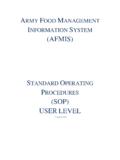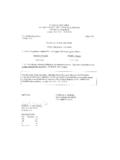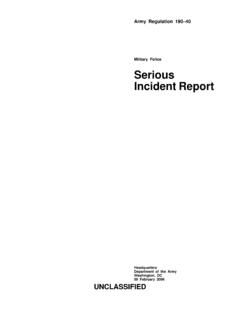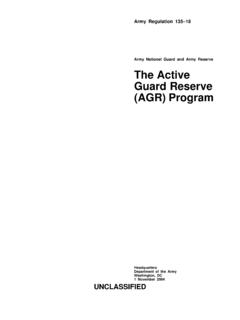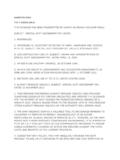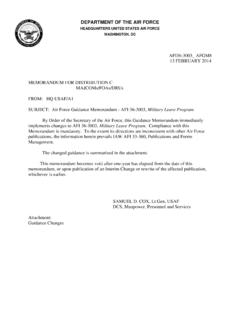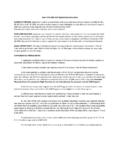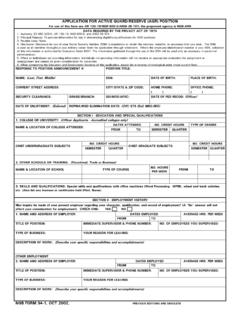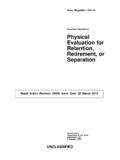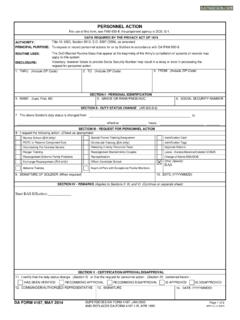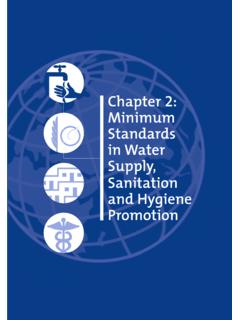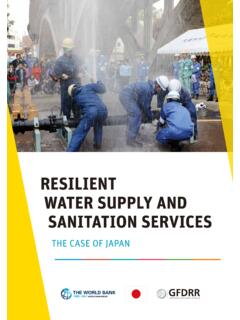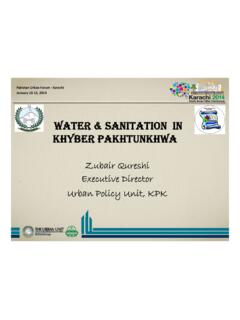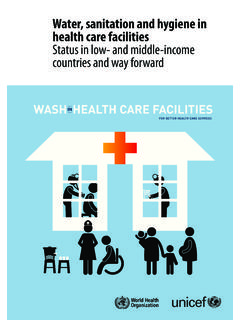Transcription of LESSON 4: Water Supply in the Field
1 LESSON 4: Water Supply in the Field TYPE OF INSTRUCTION: Lecture and practical exercise TRAINING TIME: 4 Hours TOOLS, EQUIPMENT, AND MATERIALS: Water trailer, 5-gallon Water can, 1 quart canteen, iodine tablets, Chlorfloc tablets, 6 oz. Jar calcium hypochlorite, half-gram spoon, HACH Aquacheck Test Strips for Total and Free Chlorine. PERSONNEL: One instructor, MOS 91S or AOC 72 series INSTRUCTIONAL AIDS: Projection equipment, screen, PowerPoint presentations REFERENCES: FM 21-10, Field Hygiene and sanitation ; FM , Unit Field sanitation Team; TB MED 577, Sanitary Control and Surveillance of Field Water Supplies. STUDY ASSIGNMENT: FM , Chapter 2. STUDENT UNIFORM AND EQUIPMENT: Duty uniform w/1 quart canteen and canteen cup; Soldier s Guide and pencil/pen; FM 21-10; FM TRANSPORTATION REQUIREMENTS: None Section I. INTRODUCTION Show Slide FSTCC0004-1: Title OPENING STATEMENT: In combat, safe Water ranks in importance with ammunition and food.
2 It often has an important bearing on the success or failure of a mission. In this LESSON you will learn the importance of Water in the practice of sanitation , responsibilities for producing safe Water in the Field , sources of safe Water , and procedures for disinfecting Water . Show Slide FSSTCC0004-2: LESSON Objective NOTE: Inform the students of the enabling learning objectives for this LESSON . MED153-IM 4-1 LESSON OBJECTIVES After completing this LESSON , you should be able to: 4-1. Match a list of terms related to Water treatment with a list of corresponding definitions. 4-2. Identify the importance of Water in the practice of sanitation . 4-3. Determine the required quantity of potable Water for a unit. 4-4. Match a list of organizations with their respective responsibilities for the production of potable Water in the Field . 4-5. Identify the rules of Water discipline.
3 Show Slide FSSTCC0004-3: LESSON Objective 4-6. Determine the best Water source based upon the unit's situation. 4-7. Identify Water treatment processes used in the Field . 4-8. Demonstrate the knowledge of the steps for inspection of a 400- gallon Water trailer. 4-9. Demonstrate the knowledge of the steps to disinfect Water in the Field . 4-10. Demonstrate the knowledge of the steps to perform chlorine residual monitoring. 4-11. Monitor bottle Water operations. Section II. EXPLANATION Show Slide FSTCC0004-4: Definitions 4-1. TERMS AND DEFINITIONS a. Palatable Water . Water that looks, smells, and tastes good. b. Potable Water . Water that is fit for human consumption. MED153-IM 4-2 c. Water Treatment. Procedures that are used to change the chemistry of Water to improve its quality. Show Slide FSTCC0004-5: Definitions (2) d. Disinifection. A process of killing infectious agents outside the human body by direct exposure to chemical or physical agents.
4 E. Chlorination. A treatment process that combines the Water with chlorine or chlorine compound. f. Chlorine Dosage. The total amount of chlorine or chlorine compound added to a given amount of Water . Show Slide FSTCC0004-6: Definitions (3) g. Chlorine Demand. The amount of chlorine dosage used or consumed by substances in the Water . h. Chlorine Residual. The amount of chlorine left in the Water after the chlorine demand has taken effect. i. Parts per Million (ppm). The parts of chlorine present in a given volume of Water (concentration). This value may also be expressed as Milligrams per Liter (Mg/L). Show Slide FSTCC0004-7: Water in the Field 4-2. IMPORTANCE OF Water IN THE PRACTICE OF sanitation a. Safe Water is essential. Safe Water ranks in importance with ammunition and food. Its availability often has a direct bearing on the success or failure of a mission. (1) When in the Field , soldiers must be supplied with sufficient Water to drink and maintain personal hygiene and maximum health.
5 (2) The Water must be safe to drink and should be reasonably free of objectionable tastes, odors, turbidity, and color. (NOTE: Water that is turbid is opaque with suspended foreign particles.) Show Slide FSTCC0004-8: Disease Transmission b. Water is a vehicle in disease transmission. Waterborne disease organisms are a contributing source of disease to soldiers in a Field environment. (1) Common waterborne diseases of man are hepatitis, typhoid, bacillary and amoebic dysentery, cholera, leptospirosis, giardia and schistosomiasis. MED153-IM 4-3 (2) No direct method has been developed for detecting the minimum infectious quantities of disease organisms in Water . Therefore, it is necessary to resort to an indicator test to determine the bacteriological acceptability of Water . Show Slide FSTCC0004-9: Bacteriological Testing c. Water is tested for the presence of coliform bacteria.
6 (1) Coliform bacteria are found in great numbers in the excreta (feces) of humans, warm-blooded animals, and in the soil. Because of this, Water may be contaminated many times between the point where it is produced the point of consumption. (2) Although the presence of coliform bacteria in Water may not prove fecal contamination, it is an indication that pathogenic (disease-carrying) organisms may be present. This test is the best indicator that contamination exists. (3) Many military units in the Field do not have the capability for determining the presence of coliform bacteria in Water ; so all Water must be thoroughly treated and disinfected before use. Show Slide FSTCC0004-10: Water Requirements in the Field 4-3. Water REQUIREMENTS The quantity of Water required for soldiers varies with the seasons of the year, the geographical area, and the tactical situation. Show Slide FSTCC0004-11: Quantity of Water Required for Soldiers.
7 A. A general guide for planning to meet the Water requirements in an arid zone is 3-6 gallons per individual per day unless improvised showering facilities are made available. In this case the requirement should be increased to 15-gallons or more. b. Additional amounts of Water are required for personal hygiene and cooking. c. You may think that soldiers working in a cold climate do not need as much Water for mission success as soldiers deployed to a hot desert climate. But the type of mission impacts upon this general rule. For example, soldiers marching through deep snow may need more Water than desert troops in stationary positions. NOTE: Water requirement information is available in FM 10-52. Show Slide FSTCC0004-12: Army Medical Department Responsibilities 4-4. PRODUCTION OF POTABLE Water IN THE Field MED153-IM 4-4 a. Army Medical Department responsibilities. The Army Medical Department (AMEDD) does bacteriological examinations of Water .
8 Under certain circumstances they will also check the chlorine residual and pH levels. The AMEDD also establishes standards for Water quality, inspects Water points or sources, advises the proper authorities about Water purification methods and approves Water for consumption. Show Slide FSTCC0004-13: Corps of Engineers Responsibilities b. Corps of Engineers responsibilities. The Corps of Engineers selects Water sources and establishes Water points. The selection of Water points may be based on examination of data provided by the AMEDD as well as the reconnaissance performed by engineers. Show Slide FSTCC0004-14: Quartermaster Corps Responsibilities c. Quartermaster Corps responsibilities. The Quartermaster Corps sets up and operates bulk Water treatment equipment. They procure, treat, and distribute the treated Water . Sometimes the Quartermaster Corps units transport Water to centralized distribution points (dry points) for pick-up by military units.
9 Show Slide FSTCC0004-15: Unit Commander Responsibilities d. Unit Commander responsibilities. Water Supply and Water treatment in the units are responsibilities of the unit commander. The commander makes certain that the unit has an adequate Supply of safe drinking Water ; enforces the rules of Water discipline; and ensures that each individual thoroughly understands the danger of drinking unsafe Water . It is the responsibility of the FST to assist the commander in making sure soldiers are aware of the rules of Water discipline and that they make every attempt to follow them. Show Slide FSTCC0004-16: Rules of Water Discipline 4-5. RULES OF Water DISCIPLINE Water discipline does not imply teaching soldiers to do without Water . It means using Water intelligently and not wasting it. For optimum safe Water usage in the Field , follow these guidelines. a. Drink approved Water only. b.
10 Prevent Water waste. c. Protect Water sources with good sanitary practices. Show Slide FSTCC0004-17: Sources of Water MED153-IM 4-5 4-6. Water SOURCES It is important to note that, although the selection of the Water source is the responsibility of the Corps of Engineers, you may be called upon (in their absence) to assist in selecting a suitable site. Therefore, you must be familiar with the six sources of Water and the factors you need to consider when selecting a Water source. Show Slide FSTCC0004-18: Surface Water a. Surface Water . Surface Water includes streams, ponds, rivers, and lakes. Surface Water is generally the most accessible, and is commonly selected for use in the Field . It is usually more contaminated and polluted than other Water sources. Show Slide FSTCC0004-19: Ground Water b. Ground Water . Ground Water includes wells and springs. When a surface source is not readily available, the engineers may select ground Water for use.
